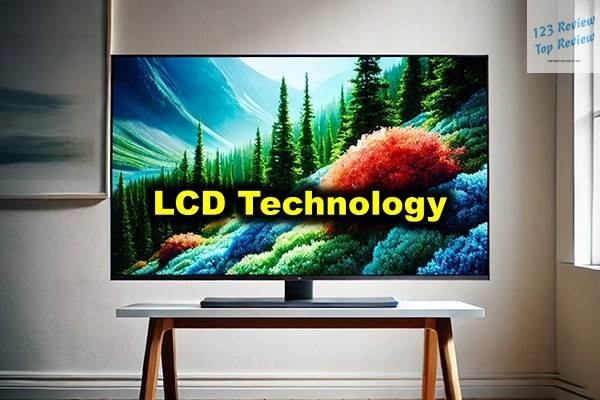In this article, 123 Review delves into the fundamentals of LCD (Liquid Crystal Display) technology, explaining how it works and its applications in everyday devices like TVs, monitors, and smartphones. Learn about the structure of LCD screens, the role of liquid crystals, and the benefits of using LCD technology, including energy efficiency and sharp image quality. Whether you’re a tech enthusiast or a consumer, this guide will help you understand the essentials of LCD technology.
What is LCD?
Definition of LCD Technology
Liquid Crystal Display (LCD) technology is a cornerstone in the realm of modern visual displays, found in everything from televisions and computer monitors to smartphones, digital signage, and automotive dashboards. LCDs operate using liquid crystals, substances that exhibit properties between those of conventional liquids and solid crystals. These crystals are the heart of the display, controlling light and color to create the images we see on the screen. Unlike older display technologies, such as Cathode Ray Tubes (CRTs), which relied on electron beams and phosphor screens, LCDs offer a more compact, energy-efficient solution. They are characterized by their thin, flat form factors, which have enabled the proliferation of portable and space-saving devices across various industries.

How LCD Works
The operation of an LCD is a sophisticated process that involves the manipulation of light at the microscopic level. An LCD screen is made up of several layers, including two polarizing filters, two glass substrates, and the liquid crystal layer sandwiched between them. The liquid crystals themselves do not emit light; instead, they modulate the light emitted by a backlight, which is typically made of Light Emitting Diodes (LEDs).
When an electric current is applied to the liquid crystals, they align in such a way that they either block or allow light to pass through them. Each pixel on an LCD screen is divided into subpixels, typically red, green, and blue (RGB). By adjusting the voltage applied to each subpixel, the crystals control the amount of light that passes through, thereby mixing these colors to create the full spectrum of visible light. This precise control over light allows LCDs to produce images with high resolution and clarity.
The backlight, often composed of white LEDs, plays a crucial role in this process. It ensures that the display is bright enough to be visible in various lighting conditions, from a dim room to bright sunlight. Additionally, modern LCDs use various backlighting techniques, such as edge-lit and full-array backlighting, to improve contrast and brightness uniformity, further enhancing the viewing experience.
History of LCD Development
The journey of LCD technology from concept to widespread adoption is a tale of innovation and perseverance. The concept of liquid crystals was first discovered in the late 19th century by Austrian botanist Friedrich Reinitzer, who observed that certain organic compounds could exist in a state between solid and liquid. However, it wasn’t until the 1960s that scientists began to explore the practical applications of liquid crystals for display technology.
The first major breakthrough came in 1968 when RCA (Radio Corporation of America) introduced the first rudimentary LCD, which utilized a segment-based display system similar to the seven-segment displays found in early calculators. This initial version was monochromatic and lacked the complexity needed for modern displays, but it laid the groundwork for further advancements.
Throughout the 1970s and 1980s, LCD technology gradually improved, driven by advancements in materials science and electronics. In 1971, Swiss chemist Martin Schadt and engineer Wolfgang Helfrich developed the twisted nematic (TN) display, which became the first commercially viable LCD technology. TN displays were initially used in small devices like calculators, digital watches, and portable electronics.
The 1990s saw significant progress, with the development of thin-film transistor (TFT) technology, which allowed for greater control over individual pixels and improved image quality. By the early 2000s, LCDs had become the dominant display technology, replacing CRTs in most applications. Innovations such as In-Plane Switching (IPS) and Vertical Alignment (VA) panels further enhanced color accuracy, viewing angles, and contrast ratios, solidifying LCDs as the standard for high-quality displays.
Types of LCD Displays
Twisted Nematic (TN) Panels
Twisted Nematic (TN) panels are the most established type of LCD technology, known for their simplicity and cost-effectiveness. The term “twisted nematic” refers to the structure of the liquid crystals, which twist and untwist to control light passage. This technology was groundbreaking when it was first developed and remains relevant today, particularly in gaming monitors where fast response times are crucial.
TN panels are characterized by their rapid response times, often as low as 1 millisecond, which makes them ideal for fast-paced gaming and other applications where minimizing motion blur is critical. This speed is achieved by the rapid alignment and realignment of the liquid crystals in response to electrical signals, allowing pixels to change colors quickly.
However, TN panels have notable drawbacks, including limited viewing angles and subpar color accuracy. When viewed from off-center angles, the colors on TN panels can appear distorted, and the overall image quality may degrade. This limitation makes TN panels less suitable for tasks that require color precision or for displays intended to be viewed by multiple people simultaneously.
In-Plane Switching (IPS) Panels
In-Plane Switching (IPS) panels were developed to overcome the shortcomings of TN panels, particularly in terms of color accuracy and viewing angles. IPS technology aligns the liquid crystals in parallel to the glass substrate, allowing them to maintain consistent color performance across a wide range of viewing angles. This means that whether you are viewing the screen head-on or from the side, the colors and contrast remain consistent.
IPS panels are renowned for their superior color reproduction, making them the preferred choice for graphic designers, photographers, and video editors who require accurate color representation. The improved viewing angles also make IPS panels ideal for televisions, tablets, and other devices used in environments where multiple people are likely to view the screen simultaneously.
While IPS panels offer many advantages, they do come with trade-offs. The response times of IPS panels are generally slower than those of TN panels, typically around 4 to 5 milliseconds, which can result in some motion blur during fast-moving scenes. Additionally, IPS panels tend to be more expensive to produce, which is reflected in the higher cost of devices that use them.
Vertical Alignment (VA) Panels
Vertical Alignment (VA) panels occupy a middle ground between TN and IPS panels, offering a blend of high contrast ratios, good color reproduction, and acceptable viewing angles. VA technology works by aligning the liquid crystals vertically when no voltage is applied, which blocks light and produces deep blacks. When voltage is applied, the crystals tilt to allow light to pass through, resulting in bright, vivid colors.
One of the standout features of VA panels is their excellent contrast ratios, often exceeding 3000:1. This capability makes VA panels particularly well-suited for environments where deep blacks and rich colors are important, such as in home theater systems and professional video editing.
VA panels also offer better viewing angles than TN panels, though they may not match the wide-angle performance of IPS panels. Additionally, VA panels generally have slower response times than TN panels, typically ranging from 4 to 8 milliseconds, which can lead to motion blur in fast-paced scenes. However, advancements in VA technology, such as the introduction of advanced multi-domain vertical alignment (AMVA) panels, have helped mitigate some of these issues, making VA panels a versatile choice for a wide range of applications.
OLED vs. LCD: Key Differences
While LCD technology has dominated the display market for decades, it faces growing competition from OLED (Organic Light Emitting Diode) technology. OLED displays operate on a fundamentally different principle from LCDs. Instead of relying on a backlight, OLEDs produce light directly from each pixel, allowing for true blacks, higher contrast ratios, and thinner, more flexible displays.
One of the key advantages of OLEDs is their ability to achieve “true black.” When an OLED pixel is turned off, it emits no light, resulting in a black level that is unmatched by any LCD technology. This capability gives OLEDs an infinite contrast ratio, which is particularly noticeable in scenes with both bright and dark elements.
OLEDs also have faster response times than LCDs, often under 1 millisecond, which eliminates motion blur and ghosting. Additionally, OLED displays can be made thinner and more flexible, enabling the creation of curved and foldable screens.
However, OLEDs have their own set of challenges, including a higher risk of burn-in, where static images can leave a permanent mark on the screen. They are also generally more expensive to produce, which has limited their adoption in budget and mid-range devices. In contrast, LCDs offer greater longevity and are less susceptible to burn-in, making them a more reliable choice for long-term use.
Applications of LCD Technology
LCD in Television Displays
The adoption of LCD technology in television displays has transformed the way we consume visual content, making high-definition entertainment accessible to millions. LCD TVs have become the standard in households worldwide, offering a wide range of sizes, resolutions, and features to suit different needs and budgets. From small bedroom TVs to large, wall-mounted home theater displays, LCD technology provides the versatility and performance required for various viewing environments.
One of the key advantages of LCD TVs is their ability to deliver sharp, detailed images with vibrant colors. This is particularly important in the era of high-definition (HD) and ultra-high-definition (UHD) content, where every detail matters. The high pixel density of LCDs ensures that even the smallest details are rendered with clarity, enhancing the overall viewing experience.
LCD TVs also benefit from advancements in backlighting technology, such as full-array local dimming and quantum dots. These innovations have improved contrast ratios and color accuracy, allowing LCD TVs to compete with more expensive display technologies like OLED. Additionally, the energy efficiency of LCDs makes them an environmentally friendly choice, consuming less power than older CRT and plasma displays.
LCD Monitors for Computers
LCD monitors have become an integral part of the computing experience, serving as the primary interface for interacting with digital content. Whether for work, gaming, or creative pursuits, LCD monitors offer the resolution, color accuracy, and performance needed for a wide range of tasks. Their prevalence in offices, homes, and educational institutions underscores their importance in modern computing.
For productivity tasks, such as word processing, spreadsheet management, and web browsing, LCD monitors provide crisp text and clear visuals, reducing eye strain during prolonged use. High-resolution LCD monitors, including those with 4K or even 8K resolutions, offer ample screen real estate, allowing users to view multiple documents or applications simultaneously. This capability is particularly beneficial for professionals in fields such as graphic design, software development, and data analysis, where multitasking and attention to detail are crucial.
Gaming is another area where LCD monitors excel, particularly those with fast refresh rates and low response times. Gaming monitors often feature refresh rates of 144Hz or higher, combined with response times as low as 1 millisecond, to deliver smooth, lag-free gameplay. These monitors also support technologies like G-Sync and FreeSync, which synchronize the display’s refresh rate with the graphics card to prevent screen tearing and stuttering.
For creative professionals, such as photographers, videographers, and graphic designers, color accuracy is paramount. IPS LCD monitors are the preferred choice in these fields due to their superior color reproduction and wide viewing angles. These monitors are often factory-calibrated to ensure that colors are displayed accurately, making them essential tools for editing and reviewing visual content.
Use of LCD in Smartphones
The proliferation of smartphones has been one of the most significant technological trends of the 21st century, and LCD technology has played a vital role in this revolution. While OLED displays are becoming increasingly common in high-end smartphones, LCDs continue to dominate the mid-range and budget segments, offering a balance of performance, cost, and energy efficiency.
LCD screens in smartphones provide bright, clear displays that are easily viewable in a variety of lighting conditions, including direct sunlight. This is achieved through high brightness levels and the use of anti-reflective coatings, which minimize glare. The durability of LCDs is another advantage, as they are less prone to burn-in and generally more resistant to long-term image retention than OLEDs.
Smartphone manufacturers have also leveraged advancements in LCD technology to deliver higher resolutions and better color accuracy. Full HD and even 4K LCD screens are now available in some smartphones, providing sharp visuals that enhance the experience of watching videos, playing games, and browsing photos. Additionally, the development of LTPS (Low-Temperature Polycrystalline Silicon) LCDs has allowed for thinner, lighter displays with improved power efficiency, further extending battery life in smartphones.
LCDs in Automotive Displays
In the automotive industry, LCD technology has become a staple in the design of modern vehicle displays. From digital instrument clusters and infotainment systems to head-up displays (HUDs) and rear-seat entertainment systems, LCDs are used to convey critical information and enhance the driving experience.
Digital instrument clusters, which replace traditional analog gauges with customizable LCD screens, provide drivers with real-time data such as speed, fuel levels, navigation instructions, and safety alerts. These displays are often designed with high brightness and contrast to ensure visibility in various lighting conditions, including direct sunlight and nighttime driving.
Infotainment systems, which serve as the central hub for audio, navigation, and connectivity features, rely on large LCD touchscreens for user interaction. These displays must be responsive, intuitive, and easy to read, with clear graphics and minimal lag. The integration of capacitive touch technology in LCDs has made it possible to create seamless, edge-to-edge glass displays that enhance the aesthetics and functionality of the vehicle interior.
LCD technology is also used in head-up displays (HUDs), which project important information onto the windshield, allowing drivers to keep their eyes on the road while receiving critical data. These displays use a combination of LCD screens and optical components to create a virtual image that appears to float in front of the driver. HUDs are particularly valuable for displaying navigation directions, speed limits, and collision warnings, contributing to safer driving.
Advantages of LCD Technology
Energy Efficiency of LCD Screens
One of the most significant advantages of LCD technology is its energy efficiency. Unlike older display technologies, such as CRTs and plasma screens, LCDs consume less power while delivering bright, high-quality images. This energy efficiency is particularly important in portable devices, such as laptops, smartphones, and tablets, where battery life is a critical factor.
The energy efficiency of LCDs is largely due to their use of LED backlighting, which is more efficient than the fluorescent backlights used in earlier LCD models. LED backlights consume less power and generate less heat, contributing to the overall energy savings of the display. Additionally, modern LCDs often feature dynamic backlighting, which adjusts the brightness of the screen based on the content being displayed. For example, darker scenes in a movie may trigger the backlight to dim, further reducing power consumption.
In large-scale applications, such as digital signage and television displays, the energy efficiency of LCDs translates into lower operating costs and a reduced environmental impact. Businesses and consumers alike benefit from the cost savings associated with lower electricity bills, while the reduced energy consumption contributes to sustainability efforts.
Slim Profile and Lightweight Design
The slim profile and lightweight design of LCD screens have revolutionized the way we design and interact with electronic devices. The thin form factor of LCDs has enabled the development of sleek, modern devices that are both portable and aesthetically pleasing. This design flexibility has had a profound impact on industries ranging from consumer electronics to automotive design and digital signage.
In consumer electronics, the thinness of LCD screens has allowed for the creation of ultra-slim laptops, tablets, and smartphones that are easy to carry and use on the go. These devices offer the performance and functionality of larger systems while maintaining a compact, lightweight form factor. The slim design also contributes to the overall durability of the device, as there are fewer components and materials that can be damaged or broken.
In the automotive industry, the slim profile of LCD screens has enabled the integration of displays into various parts of the vehicle, such as dashboards, center consoles, and even rearview mirrors. These displays provide drivers and passengers with essential information while maintaining a clean, uncluttered interior design. The lightweight nature of LCDs also contributes to fuel efficiency by reducing the overall weight of the vehicle.
Digital signage and advertising have also benefited from the slim and lightweight design of LCDs. Large-format LCD displays can be mounted on walls, suspended from ceilings, or integrated into kiosks without requiring bulky support structures. This flexibility allows businesses to create eye-catching, dynamic displays in a variety of environments, from retail stores and airports to outdoor billboards.
High Resolution and Image Clarity
LCD technology is renowned for its ability to deliver high-resolution images with exceptional clarity. The high pixel density of LCD screens ensures that even the most detailed images are rendered with sharpness and precision, making them ideal for a wide range of applications, from medical imaging and graphic design to gaming and home entertainment.
In medical imaging, for example, the high resolution and clarity of LCD monitors are essential for accurately interpreting complex images, such as X-rays, MRIs, and CT scans. The ability to display fine details and subtle differences in shading allows medical professionals to make accurate diagnoses and treatment decisions.
For graphic designers and photographers, the high resolution of LCD screens enables them to work with high-definition images and video content, ensuring that their work is displayed with the utmost precision. The accurate reproduction of colors and fine details is crucial for editing and reviewing visual content, where even the smallest discrepancies can impact the final product.
Gamers also benefit from the high resolution and image clarity of LCD monitors, which allow them to experience games with lifelike visuals and immersive environments. The sharpness of the display enhances the realism of the gaming experience, making it easier to spot details and react quickly to in-game events.
Longer Lifespan Compared to Other Technologies
The durability and longevity of LCD technology are among its most significant advantages, particularly when compared to other display technologies like CRTs, plasma screens, and even OLEDs. LCD screens are designed to last for many years, with minimal degradation in image quality over time. This long lifespan makes LCDs a cost-effective choice for consumers and businesses alike.
The longevity of LCD screens is partly due to the robustness of the materials used in their construction. The liquid crystals and glass substrates are less susceptible to wear and tear than the phosphor coatings used in CRTs or the organic materials in OLEDs. Additionally, the use of LED backlighting, which has a longer lifespan than the fluorescent backlights used in earlier LCD models, contributes to the overall durability of the display.
While OLED screens are known for their vibrant colors and deep blacks, they are more prone to burn-in, where static images can leave a permanent mark on the screen. This issue is particularly problematic for applications where static images, such as logos or user interfaces, are displayed for extended periods. In contrast, LCDs are less susceptible to burn-in, making them a more reliable choice for long-term use.
In commercial settings, such as digital signage and control rooms, the long lifespan of LCD screens reduces the need for frequent replacements, resulting in lower maintenance costs and less downtime. This reliability is crucial in environments where continuous operation is required, such as in airports, hospitals, and industrial control centers.
Disadvantages of LCD Technology
Limited Viewing Angles
One of the most significant disadvantages of LCD technology, particularly in older or lower-end models, is the limited viewing angles. This issue arises because the liquid crystals in an LCD panel are aligned in a way that optimizes the display for viewing from a specific angle, usually head-on. As the viewing angle deviates from this optimal position, the colors and contrast can shift, leading to a degraded viewing experience.
This limitation is particularly noticeable in TN panels, which are known for their narrow viewing angles. When viewed from the side, top, or bottom, TN panels can exhibit color distortion and reduced brightness, making it difficult for multiple people to view the screen simultaneously. This can be a significant drawback in environments where the display needs to be visible to a group of people, such as in conference rooms or classrooms.
While IPS and VA panels offer improved viewing angles compared to TN panels, they are not entirely free from this issue. IPS panels, for example, are known for their wide viewing angles and accurate color reproduction, but they can still experience some color shifting when viewed from extreme angles. VA panels, on the other hand, offer better contrast but may suffer from color distortion when viewed from the side.
Manufacturers have made strides in addressing the issue of limited viewing angles by developing advanced LCD technologies, such as IPS (In-Plane Switching) and VA (Vertical Alignment) panels. These technologies offer wider viewing angles and better color consistency across different angles, making them more suitable for applications where the display needs to be viewed by multiple people or from various positions.
Backlight Bleeding
Backlight bleeding is another common issue associated with LCD technology, particularly in lower-quality panels. This phenomenon occurs when the LED backlight leaks through the edges or corners of the screen, resulting in uneven illumination and a “glow” effect in dark scenes. Backlight bleeding is most noticeable in high-contrast situations, such as when watching movies with dark scenes or using the display in a dimly lit room.
While backlight bleeding does not typically affect the overall functionality of the display, it can be a distraction and detract from the viewing experience. For users who prioritize image quality, such as photographers, videographers, and gamers, backlight bleeding can be a significant drawback.
Manufacturers have implemented various techniques to minimize backlight bleeding, such as improving the uniformity of the backlight and enhancing the precision of the panel assembly process. However, even with these improvements, some degree of backlight bleeding may still be present in LCD panels, particularly in budget models.
In recent years, technologies such as local dimming and full-array backlighting have been developed to address the issue of backlight bleeding. These technologies allow for more precise control of the backlight, reducing the likelihood of light leakage and improving the overall contrast and image quality of the display.
Response Time and Motion Blur
Response time refers to the speed at which an LCD screen can change from one color to another, typically measured in milliseconds (ms). While modern LCD monitors have made significant improvements in response time, particularly those designed for gaming, this aspect of performance can still be a limitation for certain applications.
Longer response times can result in motion blur, where fast-moving objects on the screen appear smeared or blurry. This effect is particularly noticeable in fast-paced video games, action movies, and sports broadcasts, where quick movements are common. Motion blur can reduce the clarity of the image and make it more difficult to track fast-moving objects, potentially impacting the overall viewing experience.
To mitigate the effects of motion blur, manufacturers have developed LCD panels with faster response times, often achieved by using overdrive technology. Overdrive works by increasing the voltage applied to the liquid crystals, allowing them to change states more quickly. However, this can sometimes lead to other artifacts, such as ghosting, where a faint trail of the previous image lingers on the screen.
While TN panels generally offer the fastest response times, they may sacrifice color accuracy and viewing angles compared to IPS and VA panels. For gamers and users who prioritize fast response times, choosing a monitor with a refresh rate of 120Hz or higher, combined with a response time of 1ms or lower, can help minimize motion blur and provide a smoother visual experience.
Color Reproduction Limitations
While LCD technology has made significant strides in color accuracy, particularly with the development of IPS panels, it still faces limitations in color reproduction compared to OLED displays. OLED screens are known for their ability to produce true blacks and a wider color gamut, resulting in more vibrant and lifelike images. In contrast, LCD screens rely on a backlight that can limit their ability to achieve the same level of color depth and contrast.
This limitation is most apparent in dark scenes, where LCDs may struggle to display deep blacks, often resulting in a grayish or washed-out appearance. The inability to turn off individual pixels, as OLEDs can, means that LCDs cannot achieve the same level of contrast, particularly in high-contrast scenes where bright and dark elements are displayed simultaneously.
Additionally, the color accuracy of LCD screens can vary depending on the quality of the panel and the calibration settings. While high-end IPS monitors are often factory-calibrated for color accuracy, lower-end models may require manual calibration to achieve optimal color performance. Even with calibration, some LCDs may not be able to reproduce the full color spectrum, making them less suitable for professional applications where precise color matching is required.
Despite these limitations, LCD technology continues to be the dominant display technology due to its balance of performance, cost, and versatility. For most consumers, the color reproduction capabilities of LCD screens are more than adequate for everyday tasks, such as web browsing, content creation, and media consumption. However, for users who demand the highest level of color accuracy and contrast, OLED displays may be a better choice.
Future of LCD Technology
Advancements in LCD Panels
The future of LCD technology is bright, with ongoing advancements aimed at improving performance, energy efficiency, and overall user experience. One of the most promising developments is the introduction of Mini-LED backlighting, which significantly enhances the contrast and brightness of LCD screens. Mini-LED technology uses thousands of tiny LEDs to create a more uniform backlight, allowing for finer control over dimming zones and reducing issues like backlight bleeding.
Another area of innovation is the development of Quantum Dot LCDs, which incorporate nanocrystals that emit specific colors when exposed to light. These Quantum Dots can enhance the color accuracy and brightness of LCD screens, making them competitive with OLED displays in terms of color reproduction and overall image quality. Quantum Dot technology is already being used in some high-end televisions and monitors, and its adoption is expected to grow in the coming years.
Flexible LCDs are also on the horizon, offering new possibilities for device design and user interaction. These bendable and foldable displays could lead to the development of new form factors for smartphones, tablets, and other portable devices, allowing for more versatile and innovative product designs. Flexible LCDs could also be used in wearable technology, automotive displays, and other applications where traditional rigid screens are not suitable.
Energy efficiency remains a key focus for LCD technology, particularly in the context of environmental sustainability. Researchers are exploring new materials and manufacturing processes that could further reduce the power consumption of LCD screens, making them even more energy-efficient and environmentally friendly. These advancements are particularly important as the demand for digital displays continues to grow, driven by the proliferation of smart devices, digital signage, and other applications.
Competing Technologies
While LCD technology continues to evolve, it faces increasing competition from other display technologies, particularly OLED and MicroLED. OLED screens offer several advantages over LCDs, including true blacks, a wider color gamut, and faster response times. However, OLEDs are also more expensive to produce and can suffer from issues like burn-in and limited lifespan.
MicroLED technology is another emerging competitor, offering the potential for even better performance than OLEDs. MicroLED displays use tiny, self-emissive LEDs that can achieve high brightness, true blacks, and excellent color accuracy. Unlike OLEDs, MicroLEDs are not prone to burn-in and have a longer lifespan, making them an attractive option for high-end displays. However, MicroLED technology is still in the early stages of development and is currently more expensive to manufacture than both LCDs and OLEDs.
Despite the competition, LCD technology is expected to remain a dominant force in the display market for the foreseeable future. The ongoing advancements in LCD panels, combined with their cost-effectiveness and versatility, ensure that LCD screens will continue to be widely used in a variety of applications. However, as alternative technologies like OLED and MicroLED mature and become more affordable, the display landscape may shift, with each technology finding its niche based on performance, cost, and application requirements.
Integration with Emerging Technologies
The integration of LCD technology with emerging technologies, such as artificial intelligence (AI), the Internet of Things (IoT), and 5G connectivity, is expected to drive new applications and use cases for LCD screens. For example, AI-powered image processing algorithms could be used to enhance the image quality of LCD displays, optimizing brightness, contrast, and color accuracy in real-time based on the content being viewed.
In the context of IoT, LCD screens could be integrated into a wide range of smart devices, from home appliances to industrial equipment, providing users with intuitive and interactive interfaces. These smart displays could be used to monitor and control various functions, such as energy usage, security systems, and environmental conditions, making them an essential component of the connected home or smart factory.
5G connectivity is also expected to have a significant impact on the future of LCD technology, particularly in the realm of mobile devices and digital signage. The high-speed, low-latency capabilities of 5G networks will enable new forms of content delivery and interaction, such as augmented reality (AR) and virtual reality (VR) experiences, which could be displayed on high-resolution LCD screens. Additionally, 5G could facilitate the development of cloud-based applications and services that rely on real-time data processing and display, further expanding the possibilities for LCD technology.
Conclusion
LCD technology has come a long way since its inception, evolving into a versatile and widely-used display technology that powers a vast array of devices and applications. While it faces competition from emerging display technologies like OLED and MicroLED, LCD continues to hold its own due to its balance of performance, cost, and adaptability. Ongoing advancements in LCD panels, such as Mini-LED backlighting, Quantum Dot technology, and flexible displays, ensure that LCD screens will remain relevant and competitive in the years to come.
As LCD technology continues to integrate with emerging trends like AI, IoT, and 5G, it is poised to play a central role in the development of next-generation devices and applications. Whether in consumer electronics, automotive displays, digital signage, or industrial applications, LCD screens will continue to be an integral part of our digital world, providing the visual interface through which we interact with technology every day.





